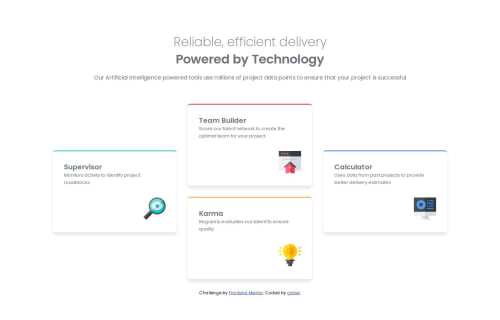Four Card Feature Section

Solution retrospective
I am most proud of the outline animation that I added for desktop users, as well as the ability to tab to the different cards. It's not entirely necessary, but it was a fun challenge to try and make it work the way I imagined.
What challenges did you encounter, and how did you overcome them?I am not experience with grid at all. I am more of a flexbox user, so I had to break out of the mold a bit to figure out how to arrange things properly. I can see the power in the grid, and I know that I've only scratched the surface.
What specific areas of your project would you like help with?I would like some critique on my usage of grid. I am pretty new to css grid and I haven't delved into best practices yet.
Please log in to post a comment
Log in with GitHubCommunity feedback
- @adeysh
Hi @gabe, I saw your code and I think your html markup with bem classes is pretty good. The animation is amazing! I also like how you have made the page responsive using simple code. I think that the code for the grid layout could be simplified by using
grid-template-areassince you're adjusting the card length to different sizes according to the screen sizes but it will be really easy to usegrid-template-areasin your code. Take a look at it and you can try to refactor and clean the code. Other-wise It looks really good and sharp. Good job 🎉Marked as helpful
Join our Discord community
Join thousands of Frontend Mentor community members taking the challenges, sharing resources, helping each other, and chatting about all things front-end!
Join our Discord